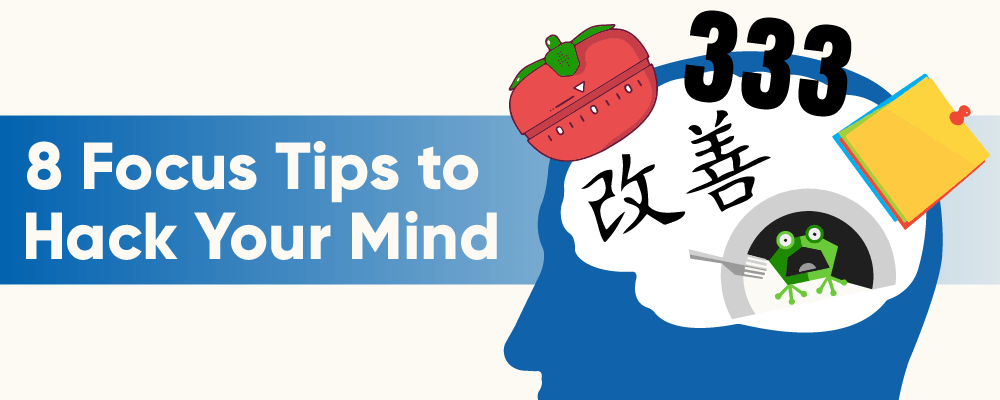8 Focus Tips To Hack Your Mind

Particularly for full-time students and parents, focus can be hard to come by. This can be due to environmental distractions, friends and family, lack of sleep, binge-watching Ted Lasso, or plain old procrastination.
You Can Change Your Habits
Good news! There are many methods to increase focus and productivity. If you’re battling a long to-do list, can’t seem to get motivated, or are stuck in the same multi-tasking wheel, I have something for you.
I know what it’s like to get distracted and need help getting back on track. Having a few systems in place helps me get focused and stay focused on work so I can enjoy what I do, and even feel good about it.
Implementing focus techniques also helps me stay on top of my work load so I can enjoy my time off without worry and stress.
Here are my top eight ways to hack my brain and increase focus. Depending on your current workflow and needs, some of these can be combined, modified, or alternated between for peak mental acuity.
8 Focus Strategies:
1. Kaizen is more of an ethos, or a mindset, than a change in daily habits. Kaizen originates from Japan in the post-war era of the 1950’s. The overarching principles of Kaizen focus on small, ongoing improvements, valuing high quality, tidy work.
You don’t have to overhaul the way you work to implement Kaizen ideology. Simply begin by engaging in a self-reflexive process of examining roadblocks and troubleshooting how to remove them. Not every moment of the day will be spent in high productivity mode, because time should also be spent thinking about how to improve your work. Taking the time to examine workflow will assist in minimizing wasted time, resources, and even products.
The earliest book on Kaizen was written by Masaaki Imai, and many have been published since. Even just one hour of reflection a week can make a difference in the quality, engagement, and relationship with your work.

2. Next up, the Pomodoro Technique. This is a really interesting time management method that I have seen a lot of graduate students use to help break down a huge project into smaller, bite sized pieces. Francesco Cirillo invented and formalized this method in the 1980’s.
Following the Pomodoro Technique means picking a task, setting a timer for 25 minutes and working on your task for 25 minutes totally uninterrupted. No phone, no email, no social media, etc. At the end of the 25 minutes of focused work, take a 5 minute break. After 4 rounds of this, take a 15-20 minute break.
If you’re working in a communal office or bullpen, those little 5 minute breaks can give you a chance to check in with a collaborator or supervisor to ensure you’re on the right path. It also assists in training your mind to focus on the task at hand until the timer goes off.
There is an official timer that you can purchase from the Pomodoro Technique website, but you don’t have to use an official timer. Some people may benefit from shorter or longer focused intervals, but should always take intentional breaks. Some tasks and projects may require many increments, while some can get completed in less than one, allowing you to cross tasks off your list and move on!

3. The 3:3:3 Method capitalizes on doing our deepest work first thing in the morning. This method was created by Oliver Burkeman, who also wrote a book.
Essentially, the first three hours of the day are dedicated to your most expansive and important project. Since our ability to focus intently tops out at three hours, it is important to actually stop working after these three hours are up.
Next, you should focus on completing three urgent tasks that will not take three hours. Finally, three tasks that will keep you organized, these are maintenance tasks. This way, we are using our tired minds to do the easy stuff like scheduling, replying to emails, and menial tasks that are essential, but not deep thinking.
4. The Kanban System is another Japanese workflow practice. If you use a task management system like Trello, you may already be using Kanban to help organize your work and focus.
Kanban uses a visual system to track projects and tasks, using different colors and boards, from ‘requested’ to ‘in-progress’ to ‘complete’. This is especially helpful for managing many overlapping projects or tasks with multiple collaborators. One of the great benefits of the Kanban System is its visual nature. All it takes is a quick glance to see how a project is progressing.

5. Eat the Frog is a way of prioritizing and working formalized by Brian Tracy. This one is for the procrastinators! When you ‘eat the frog’, you focus on one big project that MUST get done and do not move on until it’s over, no matter how much you don’t want to deal with it.
Eating the frog can only be done one thing at a time - no multitasking here. Getting the hardest and most important task done first frees you up to focus on a more creative or enjoyable part of your day.
Ideally, eating the frog gives you the habits that help you tackle the major tasks each morning. One of the supporting principles in eating the frog is don’t delay - meetings and lengthy discussions are not likely to help you actually complete your tasks. Just ‘hop’ to it 😜 and get in the habit of facing daunting or unpleasant tasks head on.
6. Laser Focus: L-Theanine is an amino acid found in green tea leaves. Not only is it useful in things like improving sleep and managing stress, it has been studied to help improve cognition and focus when taken as a supplement.
7. Calm Disposition: GABA is another amino acid and is naturally produced in your brain. GABA acts as an inhibitory neurotransmitter and is responsible for helping calm the central nervous system. For this reason, people often supplement with GABA for the many benefits it can provide.
One of the main benefits of supplementing with GABA is to induce a calm state for work, thereby supporting focus and productivity even in the face of deadlines and multiple workload demands.
8. Jump start with caffeine, our good friend. Caffeine is one of the most widely consumed mental stimulants. Many people get caffeine and that mental boost of focus and energy through coffee, energy drinks, or soda.
Personally, I don’t leave the house unless I’ve had coffee, because I am a diehard caffeine junkie!
However, if you don’t want the calories and sugar that often comes with those beverages, supplementing with caffeine can be a great alternative!
This can help keep track of exactly how much caffeine you are consuming each day and can be combined with other supplements like L-theanine or a pre-workout for added benefits.
It’s Up To You
This is not an exhaustive list, but it’s a start if you’re struggling to focus and get things done. In addition to supplementation and focus strategies, it’s important to keep in mind that you also need healthy amounts of sleep, rest, recreation, and nutrients to feel your best.
You can hack your mind and take care of your body, but remember that you are a whole being with heart, soul, and feelings that need care as well. You deserve to not only have your basic needs met, but find community, fulfillment, and meaning in your life. Begin by making small changes today to create your best and happiest self.











